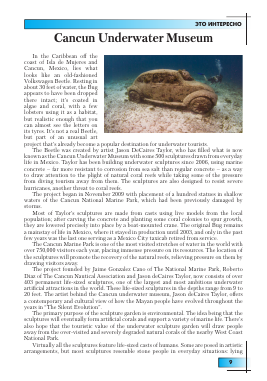Cancun Underwater Museum
In the Caribbean off the coast of Isla de Mujeres and Cancun, Mexico, lies what looks like an old-fashioned Volkswagen Beetle. Resting in about 30 feet of water, the Bug appears to have been dropped there intact; it's coated in algae and coral, with a few lobsters using it as a habitat, but realistic enough that you can almost see the letters on its tyres. It's not a real Beetle, but part of an unusual art project that's already become a popular destination for underwater tourists.
The Beetle was created by artist Jason DeCaires Taylor, who has filled what is now known as the Cancun Underwater Museum with some 500 sculptures drawn from everyday life in Mexico. Taylor has been building underwater sculptures since 2006, using marine concrete - far more resistant to corrosion from sea salt than regular concrete - as a way to draw attention to the plight of natural coral reefs while taking some of the pressure from diving tourism away from them. The sculptures are also designed to resist severe hurricanes, another threat to coral reefs.
The project began in November 2009 with placement of a hundred statues in shallow waters of the Cancun National Marine Park, which had been previously damaged by storms.
Most of Taylor's sculptures are made from casts using live models from the local population; after carving the concrete and planting some coral colonies to spur growth, they are lowered precisely into place by a boat-mounted crane. The original Bug remains a mainstay of life in Mexico, where it stayed in production until 2003, and only in the past few years was the last one serving as a Mexico City taxicab retired from service.
The Cancun Marine Park is one of the most visited stretches of water in the world with over 750,000 visitors each year, placing immense pressure on its resources. The location of the sculptures will promote the recovery of the natural reefs, relieving pressure on them by drawing visitors away.
The project founded by Jaime Gonzalez Cano of The National Marine Park, Roberto Diaz of The Cancun Nautical Association and Jason deCaires Taylor, now consists of over 403 permanent life-sized sculptures, one of the largest and most ambitious underwater artificial attractions in the world. These life-sized sculptures in the depths range from 9 to 20 feet. The artist behind the Cancun underwater museum, Jason deCaires Taylor, offers a contemporary and cultural view of how the Mayan people have evolved throughout the years in "The Silent Evolution".
The primary purpose of the sculpture garden is environmental. The idea being that the sculptures will eventually form artificial corals and support a variety of marine life. There's also hope that the touristic value of the underwater sculpture garden will draw people away from the over-visited and severely degraded natural corals of the nearby West Coast National Park.
Virtually all the sculptures feature life-sized casts of humans. Some are posed in artistic arrangements, but most sculptures resemble stone people in everyday situations: lying
asleep, riding a bicycle, typing on a keyboard and so on. The whole thing is like an underwater version of the lava-hardened city of Pompeii. To us it is all very creepy.
Each sculpture has it's own meaning such as The Dream Collector, Man on Fire and The Silent Evolution. The first sculpture collection, The Silent Evolution, was sunk in two phases and includes life-sized human figures such as Rosario, the sculptor's Spanish teacher when he first came to Mexico, and Lily Chacon, who portrays the image of the Pregnant Woman. All the sculptures change over time as they become populated by marine life: a girl acquires a fur composed of algae; a starfish implants itself on a nun's face.
The newest phase of the museum includes the museum's first kinetic sculpture, Phoenix, the figure of a woman with movable wings of living purple gorgonians (sea fan) that appear to beat with the wave cycles. The Listener, a human form assembled entirely from casts of human ears molded during a workshop of local Cancun 8- to 12-year-olds, is equipped with an underwater listening device that projects the sounds of the reef.
The artist's philosophy is telegraphed harshly in The Last Supper, a dining table carved from a rock outcropping. Half-eaten fish suppers lie on both plates, and the centerpiece consists of apples and hand grenades, illustrating the peril oceans face because of over-fishing.
It seems that the project has sparkled great interest worldwide and will keep on going for many years to come. The museum installation occupies a total of over 1,600 sq. feet (150 sq. metres) and weighs over 120 tons, and will one day form an artificial ecosystem where various fish and marine mammals will thrive.
Т.С. Тютюнникова
Сведения об авторе: Тютюнникова Татьяна Семеновна, учитель МОУ СОШ № 73, г. Оренбург.
E-mail: tatyana-t1@yandex.ru
Ключевые слова: Cancun, underwater museum, sculptures.
Для дальнейшего прочтения статьи необходимо приобрести полный текст. Статьи высылаются в формате PDF на указанную при оплате почту. Время доставки составляет менее 10 минут. Стоимость одной статьи — 150 рублей.
